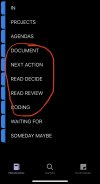Stefan Godo
GTD Connect
So much on coincidences.
I just made a note to myself to write a post about contexts this Monday. Obviously, thinking is now almost unnecessary, given the excellent and deep thoughts here. Thanks to all!
Maybe a systematic wrap-up:
context = (set of) regularly happening limiting or enabling condition(s) necessary for a given action to be possible/effective
context types:
1. physical (just the ones we are teaching in our courses - place/person/tool/system)
virtual:
2. mental (energy / mindset (creative/maintenance/admin/learning...))
not listed
3. emotional (good mood, sad....) - for some people even this is relevant.
obviously, elaborate combinations can be created (If I am a gardener, a too long "in the garden" list might not make sense, I need to subdivide it by weather conditions...).
So one needs to find which limiting/enabling conditions are relevant for him/her - at a given time. As Dave Edwards said above - significant life changes require context adjustment/finetuning.
Have a beautiful day!
I just made a note to myself to write a post about contexts this Monday. Obviously, thinking is now almost unnecessary, given the excellent and deep thoughts here. Thanks to all!
Maybe a systematic wrap-up:
context = (set of) regularly happening limiting or enabling condition(s) necessary for a given action to be possible/effective
context types:
1. physical (just the ones we are teaching in our courses - place/person/tool/system)
virtual:
2. mental (energy / mindset (creative/maintenance/admin/learning...))
not listed
3. emotional (good mood, sad....) - for some people even this is relevant.
obviously, elaborate combinations can be created (If I am a gardener, a too long "in the garden" list might not make sense, I need to subdivide it by weather conditions...).
So one needs to find which limiting/enabling conditions are relevant for him/her - at a given time. As Dave Edwards said above - significant life changes require context adjustment/finetuning.
Have a beautiful day!

